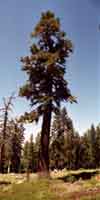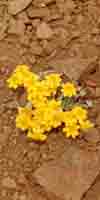


Good morning. Waking view snow camping site in the Lake Tahoe Basin. Path is to my craphole, made yesterday.
The Trails
Current Weather Conditions
Gear
Testing yourself and your gear
High Sierra Nevada Backpacking Gear
Testing
You and Your Gear
Languages
Trail Arts
Trail Skills
Food
Other
| HOME PAGE | GEAR LIST | GETTING STARTED | LAYERING | BOOTS | TRAIL SKILLS | GEAR FORUM | trail guide index | all pages | maps index |
| Hitting the Trail |
Step by Step Note the character and demands of your locale, and gear-up accordingly. Car Camping Cook on your stove, and test your food plan for quantity, taste and satisfaction. Experience just how warm your layering plan keeps you at night. Practice setting-up your tent, and get a sense of how your degree of cold sensitivity is being served by your clothing and sleeping setup. How's the mosquito protection plan working out? Have you shit cleanly into a hole? If you live near high elevation (7000 feet +) car camping spots you will experience a crisp evening chill, as in the High Sierra. Living at low elevations requires you must understand that what works during low elevation nighttime temps may well be insufficient for high elevation nighttime lows. The same is true for every aspect of life. Breathing itself can become strained. Walking on flat land will not prep you for hiking up steep high elevation Sierra flanks to the Sierra Crest. That's why you have to run your fat ass. Being trained offsets some degree of the initial altitude, weight, and climbing strains induced by Backpacking the Sierra. Especially if you are used to low-altitude warm environments, unladen hiking, and flatlands. Oh-No! Sierra conditions can shift from hot to cold and back six times during the span of a day. Your operating principal is to protect yourself by properly matching gear for the environment, to have the range of layers and depth of gear required the by the range of weather you will experience. To do that you must be informed and prepared. Informed about your own particular level of sensitivity to cold, the status and capabilities of your level of fitness, and prepared with the correct gear and trip plan suited to both. To figure out your capacities requires testing. To figure out weather conditions in the Sierra Nevada requires information. I've woven together extensive weather information and resources. These are centralized on the High Sierra Weather Page. This is our general backpacker's resource covering every aspect of High Sierra Weather. Next, I've broken down weather resources regionally, so users of various sections of the guide can more easily access the latest weather information pertinent to their specific locations. Each page of the trail guide is linked to that region's weather page listing local weather assets, such as the nearest local real time ground reporting stations, local forecasts, local radar, and the regional satellite views. Wide Range of the Wild Side Engage Thyself One is fun, the other is not. Well, not until it's over. Endless CYA We each have weakness and ignorance along with strength and intelligence. Little can stop us IF we can get beyond our own self-imposed limitations. How we approach the process of dynamically identifying and balancing our strengths and weaknesses each against the others within the challenges of our ever-changing High Sierra environment defines a big chunck of who we really are as people, when all social bullshit is stripped away. The Simple Life Car Camping If we are car camping along one of the trans-Sierra Highway we will locate the PCT or TYT and hike to the top of the Sierra Crestline with our fully-loaded "test" backpack. From Sonora Pass on Highway 108 that would be Leavitt Peak. From Ebbetts Pass on Highway 4 it's Tyron Peak, while Round Top and the Sisters overlooks Carson Pass on Highway 88. We'll plan a half-day "turnaround" hike. We'll hike up for the first half of the day before we turn around and hike back to camp during the second half. My theory is that a couple of nights of car camping along the Sierra Crest complimented by carrying your fully-loaded pack to the crest a couple of times during those days will exactly ascertain what level of conditioning you support, how well your gear and logistics are keeping you warm and well fed, and exactly how you feel doing it. These car camping "tests" of your gear and fitness will very effectively tie your assumptions and expectations to your actual capacities. This information will guide adjustmenting to your training, gear selection, and trip-planning to the actual realities of the trail before launching a long-distance High Sierra backpacking trip. That's why I suggest the "safety-net" of car camping. Failure of mind, body, or gear sits next to a car's protection and means of escape. Your car camping trips will naturally evolve into launching-points for multi-night backpacking trips once you, the wife (GF?) and kids become familiar and comfortable with the environment and its demands. You will pull in and camp for the evening, adjusting to altitude. The next morning you get an early start for your backpacking/day hiking day. Car camping provides a natural and comfortable foundation to begin your transition from city, to trailside, to trail. Once I became familiar and comfortable with High Sierra backpacking I evolved series of seasonal trips to explore as many of its aspects as possible. Each Winter I have a series of regular trips over the course of Winter anchored by what I call, "the Winter Circle." THE WINTER CIRCLE These views come from a custom truck camping site I set up on a spur off an old mining road/track left behind from the silver rush days overlooking both mountain ranges on my way over the White Mountains and down into the North end of Death Valley ending a mid-Winter series of trips by dropping into this incredible sunken desert. In my opinion the only time for smart backpackers to visit Death Valley is during Wintertime. Well, once any snows have melted off the White Mountains, and we're pretty sure no more is coming... Heading down to Death Valley is my favorite way to end a classic series of mid-Winter High Sierra backpacking trips. Nice Adventure There's a reason it's called Death Valley. 20 degrees at night to 75 degrees during the day is a big swing.
THIS PAGE IS COME ON BACK NOW, 'YA HEAR? Add your Gear Tech |
Last page: GEAR LIST Next page: TRAIL SKILLS
Backpacker ForumsHave a great Sierra Nevada route or trip to relate?Post it on The High Sierra Backpacker's Trail and Topics Forums
Experiences, comments, or pictures about GEAR?
|
Trailhead
Contact
Alex Wierbinski

Backpacking Lake Tahoe to Mount Whitney
Your guide to the High Sierra Crest, including the Tahoe to Yosemite, Pacific Crest, and John Muir Trails
